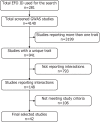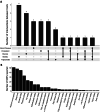Appraisal of Gene-Environment Interactions in GWAS for Evidence-Based Precision Nutrition Implementation
- PMID: 35948824
- PMCID: PMC9750926
- DOI: 10.1007/s13668-022-00430-3
Appraisal of Gene-Environment Interactions in GWAS for Evidence-Based Precision Nutrition Implementation
Abstract
Purpose of review: This review aims to analyse the currently reported gene-environment (G × E) interactions in genome-wide association studies (GWAS), involving environmental factors such as lifestyle and dietary habits related to metabolic syndrome phenotypes. For this purpose, the present manuscript reviews the available GWAS registered on the GWAS Catalog reporting the interaction between environmental factors and metabolic syndrome traits.
Recent findings: Advances in omics-related analytical and computational approaches in recent years have led to a better understanding of the biological processes underlying these G × E interactions. A total of 42 GWAS were analysed, reporting over 300 loci interacting with environmental factors. Alcohol consumption, sleep time, smoking habit and physical activity were the most studied environmental factors with significant G × E interactions. The implementation of more comprehensive GWAS will provide a better understanding of the metabolic processes that determine individual responses to environmental exposures and their association with the development of chronic diseases such as obesity and the metabolic syndrome. This will facilitate the development of precision approaches for better prevention, management and treatment of these diseases.
Keywords: Cardiometabolic health; Environmental factors; Gene-environment interaction (GEI); Genome-wide association study (GWAS); Metabolic syndrome; Precision nutrition.
© 2022. The Author(s).
Conflict of interest statement
The authors have no conflicts of interest to declare.
Figures




Similar articles
-
Heuristic Approach Uncovering Biological Significance of Gene-Lifestyle Interactions in Cardiometabolic Traits.Lifestyle Genom. 2023;16(1):106-112. doi: 10.1159/000531181. Epub 2023 Jun 20. Lifestyle Genom. 2023. PMID: 37339607
-
Deciphering Genome Environment Wide Interactions Using Exposed Subjects Only.Genet Epidemiol. 2015 Jul;39(5):334-46. doi: 10.1002/gepi.21890. Epub 2015 Feb 18. Genet Epidemiol. 2015. PMID: 25694100 Free PMC article.
-
Genome-Wide Association Study (GWAS) on Bilirubin Concentrations in Subjects with Metabolic Syndrome: Sex-Specific GWAS Analysis and Gene-Diet Interactions in a Mediterranean Population.Nutrients. 2019 Jan 4;11(1):90. doi: 10.3390/nu11010090. Nutrients. 2019. PMID: 30621171 Free PMC article.
-
Gene-environment interactions within a precision environmental health framework.Cell Genom. 2024 Jul 10;4(7):100591. doi: 10.1016/j.xgen.2024.100591. Epub 2024 Jun 25. Cell Genom. 2024. PMID: 38925123 Free PMC article. Review.
-
Gene-environment interactions in the study of asthma in the postgenomewide association studies era.Curr Opin Allergy Clin Immunol. 2015 Feb;15(1):70-8. doi: 10.1097/ACI.0000000000000131. Curr Opin Allergy Clin Immunol. 2015. PMID: 25479314 Review.
Cited by
-
Gene-vegetarianism interactions in calcium, estimated glomerular filtration rate, and testosterone identified in genome-wide analysis across 30 biomarkers.PLoS Genet. 2024 Jul 11;20(7):e1011288. doi: 10.1371/journal.pgen.1011288. eCollection 2024 Jul. PLoS Genet. 2024. PMID: 38990837 Free PMC article.
-
Impact of maternal cardiometabolic status after bariatric surgery on the association between telomere length and adiposity in offspring.Sci Rep. 2023 Nov 26;13(1):20771. doi: 10.1038/s41598-023-47813-2. Sci Rep. 2023. PMID: 38008763 Free PMC article.
-
Assessments of dietary intake and polygenic risk score in associations with colorectal cancer risk: evidence from the UK Biobank.BMC Cancer. 2023 Oct 18;23(1):993. doi: 10.1186/s12885-023-11482-1. BMC Cancer. 2023. PMID: 37853340 Free PMC article.
-
Frequency of Consumption of Food Groups and Cardio-Metabolic Risk Factors: A Genetically Informative Twin Study in Sri Lanka.Behav Genet. 2024 Jan;54(1):73-85. doi: 10.1007/s10519-023-10165-8. Epub 2023 Dec 22. Behav Genet. 2024. PMID: 38135768 Free PMC article.
-
Mediterranean diet and obesity polygenic risk interaction on adiposity in European children: The IDEFICS/I.Family Study.Pediatr Obes. 2025 Aug;20(8):e70023. doi: 10.1111/ijpo.70023. Epub 2025 May 19. Pediatr Obes. 2025. PMID: 40384423 Free PMC article.
References
Publication types
MeSH terms
LinkOut - more resources
Full Text Sources
Medical
Research Materials
